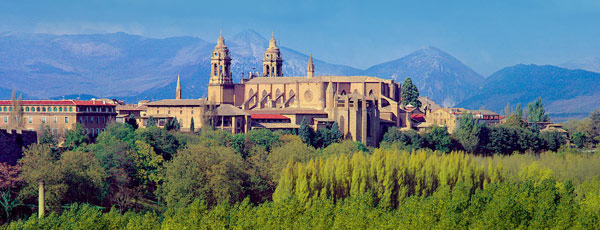Pamplona!

Its name originated as Pompeiopolis or Pompaelo from the Romans when the area was then assumed by Visigoths and briefly by the Muslims and the Frankish were in there somewhere around the 770's. With the dismantling of the Frankish king, Charlemagne in 778, Pamplona was distinguished and made capital of the kingdom of Navarre by Sancho III of Nacarre. This new land was known as the Ciudad de la Navarreria. This is when Pamplona reached its height as a blossoming and important city in Spain in the 11th century.
In 1512, King Ferdinand of Aragon-Castile penetrated Pamplona, adding a section of land south of the Pyrenees to the Navarre kingdom. When the First Carlist War (1833-1839) ended, Pamplona ceased to be the capital of the Navarre kingdom but remained the capital of the new Navarra province.
 Its merits and history were forever preserved as a significant part of Spanish history when it became a checkpoint on the Camino de Santiago.
Its merits and history were forever preserved as a significant part of Spanish history when it became a checkpoint on the Camino de Santiago.The city of Pamplona is home to several monumental buildings including the main cathedral (inside rests the Gothic cloister in the French style, this is also where Carlos III of Navarra and his wife Dona Leonor are buried), the House of Accounts (the royal treasury), the Consistory, and the Provincial Deputation.

The most famous attraction of Pamplona is one know around the world for its stimulating and grotesque festivities: the Running of the Bulls. This tradition occurs once a year and originates from honoring St. Fermin, the first bishop of Pamplona in a festival called the Fiesta de San Fermin. Festivities begin on July 6th, the eve of the festival and last until July 14th when the Running of the Bulls occurs.

The Running of the Bulls was originally called the encierro or enclosing of the bulls. Initially, the activity was to fulfill a necessity: gathering the bulls from outside the city into the bullring. It begins at the corral in Calle Santo Domingo precicely when the clock on the church of San Cernin strikes 8 AM.
"Viva San Fermin! Gora San Fermin" is the chant sung multiple times before and after the race is complete.

There is a total of four rockets fired
1: The corral gate has been opened
2: All 6 bulls have been released
3: All the bulls have entered the bullring
4: All the bulls are safely in the corral; the bull run has ended.
The dobladores are a group of people present to welcome the bulls into the bull ring upon their arrival. These are citizens with extensive bull knowledge, some even being ex-bullfighters. They help the runners fan out once in the bull ring and drag the bulls toward the corral as quickly as possible.
The total run is 825 meters through the city and takes between 2 and 10 minutes. After the first 6 bulls are released, there are three more steers that make the final sweep to ensure the bulls are all moving in the correct direction and make it into the bull ring.
Sources:
- "Pamplona, City, Spain." Encyclopedia Britannica Online. Encyclopedia Britannica, n.d. Web.
- "Running of the Bulls. San Fermin 2015. San Fermin Pamplona Spain 2015." Running of the Bulls. N.p., n.d. Web.

No comments:
Post a Comment